
Publication Details
Geolocation:
Get the Publication
$7.00
Abstract/Description:
Three closely spaced oblique-slip faults displace a Quaternary gravel and sand unit overlying Eocene Claiborne strata in the Trinity River Valley, Leon County. These steeply dipping faults strike east-northeast; two of them are downthrown toward the south, with a smaller, antithetic, central fault downthrown to the north. Maximum slip on individual faults is 118 cm (46.5 inches), decreasing to 66 cm (26 inches) where these faults displace the overlying Quaternary gravels. The location and trend of these faults are consistent with the configuration of the Mt. Enterprise-Elkhart Graben system; this relationship is verified by subsurface data and aerial photograph lineaments. The precise age of the Quaternary unit involved is uncertain. It is tentatively correlated with deposits of the Wisconsin interstadial 37,000 B.P., implying late Pleistocene or Holocene reactivation of the fault system. Mechanisms responsible for the fault may have involved fluid extraction in Long Lake Oil Field to the north, salt movement, or load-induced crustal warping. Coincidence of a belt of seismic activity with the fault trend suggests that faulting was probably related to hinge line effects between the East Texas Basin and the currently active Gulf Basin.